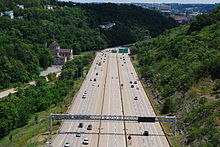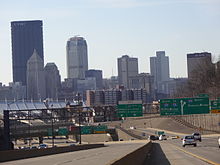Interstate 279
 From Wikipedia - Reading time: 12 min
From Wikipedia - Reading time: 12 min
| Parkway North | ||||
I-279 highlighted in red | ||||
| Route information | ||||
| Auxiliary route of I-79 | ||||
| Maintained by PennDOT | ||||
| Length | 13.32 mi[1] (21.44 km) | |||
| Existed | October 2, 1972[2]–present | |||
| NHS | Entire route | |||
| Major junctions | ||||
| South end | ||||
| North end | ||||
| Location | ||||
| Country | United States | |||
| State | Pennsylvania | |||
| Counties | Allegheny | |||
| Highway system | ||||
| ||||
Interstate 279 (I-279), locally referred to as Parkway North, is a north–south auxiliary Interstate Highway that lies entirely within Allegheny County, Pennsylvania. Its southern end is at I-376 at the Fort Pitt Bridge in Pittsburgh, and the north end is in Franklin Park at I-79. It primarily serves at the main access route between Pittsburgh and its northern suburbs.
Route description
[edit]

The southern terminus of I-279 is at I-376 in Downtown Pittsburgh. It runs concurrently with US Route 19 Truck (US 19 Truck) from its southern terminus to exit 4. (US 19 Truck continues on I-376 west.) I-279 crosses the Fort Duquesne Bridge over the Allegheny River, providing easy access to Heinz Field and PNC Park. I-579 intersects I-279 but is only accessible by southbound traffic; likewise, traffic from I-579 can only head northbound on I-279 by the I-279 Interchange. I-279 features two reversible high-occupancy vehicle lanes (HOV lanes), which begin in and near downtown and end at exit 5, an interchange with US 19. The road becomes more suburban and rural as it continues to head north. It has two additional interchanges, Bellevue/West View and Camp Horne Road. After Camp Horne Road, there are no exits until its terminus five miles (8.0 km) later. The Interstate terminates at its parent, I-79. Like the interchange with I-579, this is also a partial interchange. Traffic on I-279 is only permitted to exit northbound on I-79, while only traffic heading southbound on I-79 can exit on to I-279 south.
The section from exit 1B to exit 2B is also known as the North Shore Expressway.[3][4]
History
[edit]
I-279 was first proposed in 1958 to run along what is now I-79 between the current I-376 in Carnegie and the current I-279 in Franklin Park. On October 2, 1972, its route was swapped with I-79, putting I-279 onto its current route, although only the downtown portion and the Fort Duquesne Bridge were built at the time.[2]
In 1973, the designation was extended from downtown over Parkway West (what is now I-376) to I-79.[4] This section became part of I-376 in 2009, and the I-279 signs were taken down there.[5]
I-279 from Fort Duquesne Bridge to its current northern terminus in Franklin Park was approved on June 4, 1975, but constructed from 1985 to 1989, opening in its entirety with a Governor Bob Casey Sr. ribbon-cutting on September 16, 1989.[6] From 1997 to 2003, various ramps, the Fort Pitt Bridge, and nearby tunnels were reconstructed. A direct connection from I-279 south to I-376 east was opened in 2002.[7]
A tragedy occurred on the reversible HOV lanes in 1995 when a negligent highway worker failed to close the outbound gates, leading to a head-on collision that killed six. In 2006, to help prevent a repeat of this incident, automatic ""fast-acting" gates" were activated at the southern entrances to these HOV lanes in Downtown Pittsburgh.[8]
Unearthed cemetery
[edit]During the last phases of construction of I-279 in 1987, a long-forgotten cemetery dating from the 19th century was unearthed near the site of the current I-279/I-579 split. Archeologists spent four months exhuming the graves for cultural studies at the Smithsonian Institution, putting the Pennsylvania Department of Transportation (PennDOT) significantly behind schedule. It was determined that the graves belonged to Swiss and German immigrants that were members of a local church located next door to the cemetery in what was then Allegheny City, with 727 graves buried at the 0.5-acre (0.20 ha) site between 1833 and 1861. The graves were forgotten about by 1911 when the church did an addition to the building and had the foundation unintentionally go through about 15 graves, with the churchyard housing the cemetery later becoming a parking lot in 1950. Aside from a pair of stillborn twins, none of the graves were identified, and archeologists were unable to find any living descendants due to the obscurity of the cemetery. The remains were reburied with one marker at the church's current cemetery in the Troy Hill section of Pittsburgh in 2003 after the Smithsonian Institution finished studying them; the congregation itself disbanded in 1984 after PennDOT bought the church property via eminent domain for I-279 and only had 21 members at that point. Today, it is the largest number of 19th century graves (Native American graves notwithstanding) ever studied archeologically in the US.[9][10]
Exit list
[edit]The entire route is in Allegheny County. [11]
| Location[11] | mi[12] | km | Old exit | New exit[13] | Destinations | Notes | |
|---|---|---|---|---|---|---|---|
| Pittsburgh | 0.000 | 0.000 | – | Southern terminus; exit 70C on I-376 | |||
| 0.313 | 0.504 | 1A | Convention Center, Strip District Fort Duquesne Boulevard | Southbound left exit and northbound entrance | |||
| 0.236– 0.496 | 0.380– 0.798 | Fort Duquesne Bridge over the Allegheny River | |||||
| 0.494– 0.803 | 0.795– 1.292 | 1B | North Shore | Left exit northbound; no northbound entrance; southern end of HOV lane | |||
| 1C | Left exit and entrance northbound; US 19 not signed southbound | ||||||
| 1.020 | 1.642 | 1D | Northbound exit and southbound entrance | ||||
| 1.098 | 1.767 | – | ♦ | 9th Street | Southbound left exit and northbound entrance | ||
| 1.237 | 1.991 | – | ♦ | Southbound exit only | |||
| 1.677 | 2.699 | – | ♦ | PPG Arena | Southbound left exit and northbound entrance | ||
| 1.845 | 2.969 | 2A | Northern terminus of I-579; southbound exit and northbound entrance | ||||
| 1.910 | 3.074 | 2B | Southbound exit and northbound entrance; exit originally designated as East Street until December 2017 | ||||
| 2.903 | 4.672 | 3 | Hazlett Street | Northbound exit and entrance | |||
| 3.834 | 6.170 | 4 | East Street | Southbound exit and entrance; exit originally designated as Venture Street until December 2017 | |||
| 4.081 | 6.568 | 4 | Northern end of concurrency with US 19 Truck; northbound exit and southbound entrance HOV: northbound exit and southbound left entrance | ||||
| Ross Township | 5.469 | 8.802 | 5 | HOV: northbound left exit and southbound left entrance | |||
| 5.535 | 8.908 | Northern end of HOV lanes | |||||
| 7.304 | 11.755 | 7 | Bellevue, West View | ||||
| Ohio Township | 8.410 | 13.535 | 8 | ||||
| Franklin Park | 13.307 | 21.416 | 20[b] | – | Northern terminus; exit 72 on I-79 | ||
| 1.000 mi = 1.609 km; 1.000 km = 0.621 mi | |||||||
See also
[edit]References
[edit]- ^ "Table 2: Auxiliary Routes of the Dwight D. Eisenhower National System Of Interstate and Defense Highways". FHWA Route Log and Finder List. Federal Highway Administration. December 31, 2021. Retrieved June 6, 2022.
- ^ a b "Interstates Renumbered". The Pittsburgh Press. February 24, 1972. p. 8. Retrieved November 30, 2017 – via Newspapers.com.

- ^ "The Bridges of Pittsburgh: Veterans Memorial Bridge". Pittsburgh Post-Gazette. Retrieved September 29, 2014.
- ^ a b Kitsko, Jeffrey. "Interstate 279". Pennsylvania Highways. Archived from the original on September 21, 2023.
- ^ Schmitz, Jon (June 11, 2009). "Roads unite to form new Interstate 376". Pittsburgh Post-Gazette. Archived from the original on October 13, 2010. Retrieved June 11, 2009.
- ^ Kane, Mary (September 18, 1989). "Parkway North passes 1st tests as use speeds up". The Pittsburgh Press. Retrieved September 29, 2014 – via Google News Archive Search.
- ^ Prince, Adam; Lawson, William (January 26, 2004). "The I-279/376 Downtown Connector". GribbleNation. Kitsko, Jeff. Archived from the original on March 9, 2021.
- ^ Grata, Joe (May 19, 2006). "New HOV gates start Monday on Parkway North". Pittsburgh Post-Gazette. Archived from the original on May 22, 2011. Retrieved June 1, 2010.
- ^ Nelson Jones, Diana (August 19, 2013). "Lost Pittsburgh cemetery lives on in memories". Pittsburgh Post-Gazette. Archived from the original on October 12, 2013.
- ^ Lowry, Patricia (October 28, 2003). "New burial site for 727 souls will be blessed". Post-Gazette. Archived from the original on December 11, 2013. Retrieved August 19, 2013.
- ^ "Video Log". Pennsylvania Department of Transportation. Archived from the original on April 10, 2016. Retrieved July 16, 2016.
- ^ Bureau of Maintenance and Operations (January 2016). Roadway Management System Straight Line Diagrams (Report) (2015 ed.). Pennsylvania Department of Transportation. Retrieved July 16, 2016.
- ^ Staff (August 19, 2009). "I-376 Corridor New Exit Numbers" (PDF). Pennsylvania Department of Transportation District 11-0. Retrieved July 16, 2016.
- ^ a b "Pennsylvania Exit Numbering" (PDF). Pennsylvania Department of Transportation. Retrieved July 16, 2016.
 KSF
KSF
